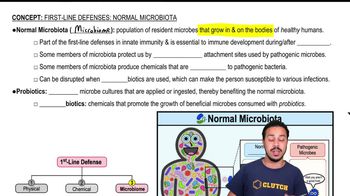Here are the essential concepts you must grasp in order to answer the question correctly.
Koch's Postulates
Koch's Postulates are a set of criteria established by Robert Koch to identify the causative agents of infectious diseases. They include the isolation of the microorganism from a diseased host, its cultivation in pure culture, and the ability to cause disease when introduced to a healthy host. Understanding these postulates is essential for evaluating the historical context of E. coli as a disease-causing bacterium.
Recommended video:
Normal Microbiome
The normal microbiome refers to the diverse community of microorganisms, including bacteria, that reside in and on the human body, particularly in the gut. E. coli is a common member of this microbiome and plays a crucial role in digestion and nutrient absorption. Recognizing the beneficial aspects of E. coli helps clarify its dual role as both a commensal organism and a potential pathogen.
Recommended video:
Pathogenic vs. Non-Pathogenic E. coli
E. coli encompasses various strains, some of which are pathogenic and can cause diseases, while others are non-pathogenic and beneficial. Pathogenic strains can lead to gastrointestinal infections and other illnesses, whereas non-pathogenic strains contribute to gut health. Understanding this distinction is vital for interpreting statements about E. coli's role in human health and disease.
Recommended video:
Introduction to Pathogenic Toxins
 Verified step by step guidance
Verified step by step guidance


